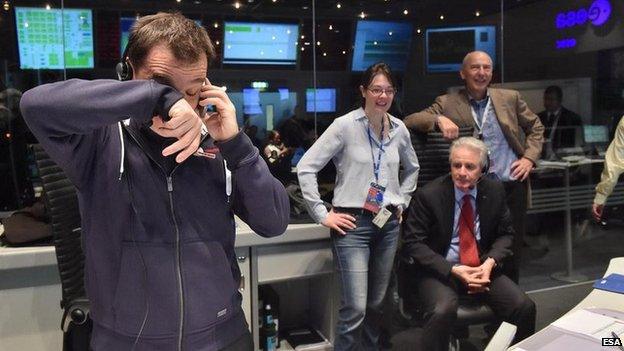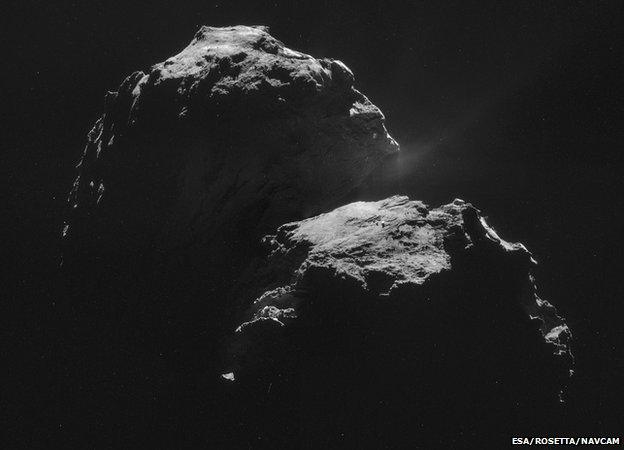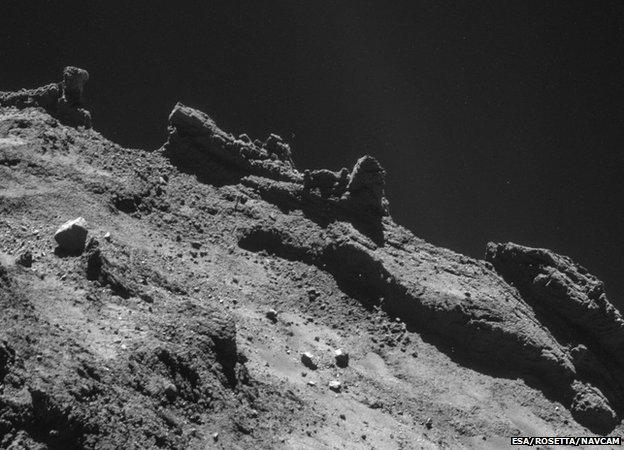Philae comet lander: Sleep well little probe
- Published
- comments

Andrea Accomazzo would like to end the Rosetta satellite's mission by also landing it on the comet
European Space Agency controllers will not give up on Philae.
They will continue to listen for the little probe in the days ahead, hopeful that it will somehow become active again.
On each pass overhead, the Rosetta satellite will try to detect and lock on to any sort of blip being transmitted from below.
The mission has faced up to the odds before, and won. It bounced and probably scraped across the surface during its historic touchdown on Wednesday.
Philae survived all that. People will now want to believe it can hunker down in the darkness and ride out its present predicament.
It would be very useful to know where exactly the probe is right now on the surface of Comet 67P.
This would give controllers a better sense of whether it is ever likely to come back to life.
The robot's own pictures show it to be rammed up against walls that throw a deep shadow over its solar panels for most of 67P's 12-hour day.
Pallab Ghosh: Philae ended up in ''a dark, jagged area'' on the comet
But the conditions that currently prevent Philae from charging its batteries could change.
It is not inconceivable that as the comet moves in closer to the Sun, the amount of light made available to the probe will increase, in amount and in intensity.
There could be structural changes on the comet, too. Obstructions that look hard and imposing today could crumble in time as 67P warms and becomes more active.
The jets of gas and dust that are generated as the comet's internal ices are heated could disturb the robot in such a way that it is bumped to a more favourable lighting location.
For sure, Philae will be very cold in the long nights it is experiencing, but the assessment of the thermal status of the probe is encouraging. It can survive.
If this is the last we hear from the robot, history will be very quick to judge this mission as an astonishing success.

Yes, the robot had some systems failures in its landing mechanisms, but it would be churlish in the extreme to dwell on these shortcomings.
The robot delivered almost 100% of its primary goals, returning the first-ever pictures and other science data from the surface of a comet.
And it has been a blast. This past week's events really caught the world's attention.
So how about we do it again? This is the dream certainly of many who control Philae's mothership, Rosetta.

The strange shape of 67P turned an already challenging prospect into an extremely daunting one
It will continue to orbit and observe 67P for at least another year, but after that there is a desire to put the satellite on the surface of the comet as well.
"I would like to land on the surface of the comet with the full spacecraft - definitely," says European Space Agency flight director Andrea Accomazzo.
"In the end, we can design an approach trajectory to the comet. We just slow down the spacecraft and it falls on to the comet.
"The touchdown will not be as soft as the lander. There's no landing gear; the spacecraft would be mechanically damaged. But we can do it."
And Paolo Ferri, Esa's head of mission operations, added: "We would plan such a manoeuvre so that we could follow Rosetta down to the surface. But once it touches down, we cannot control anymore the attitude. So, the antenna will not be pointing to the right direction.
"We would lose the contact when it touches down, but we would still be able to control it down to the last metre, to get signal, measurements and pictures. It would be spectacular. That's the right way to die."
You can hear more from Accomazzo and Ferri in the BBC Radio 4 Frontiers special we recorded from mission control on Wednesday night - if you haven't already caught the programme.
And there'll be a special Sky At Night edition dedicated to Philae's exploits on BBC Four television this Sunday at 2100 GMT.

What scientists learn from Rosetta and Philae will re-write the textbooks - of that, there is no doubt